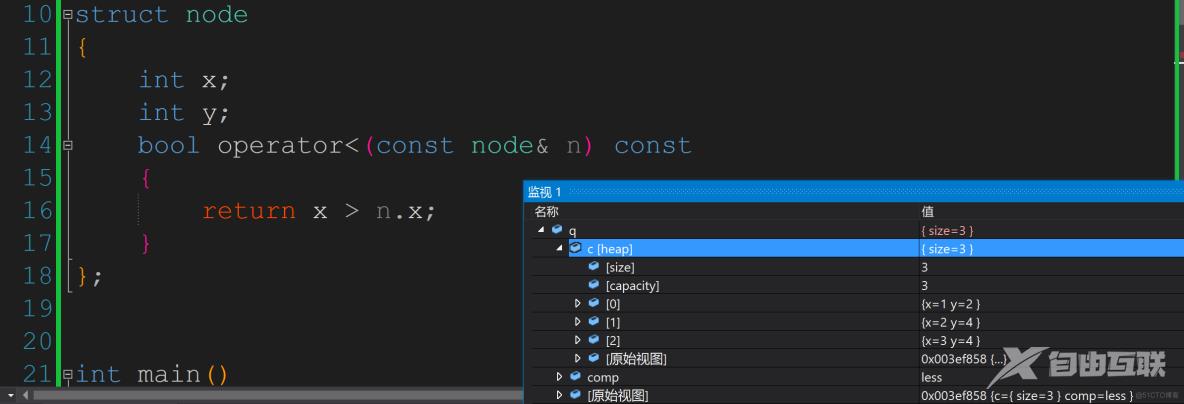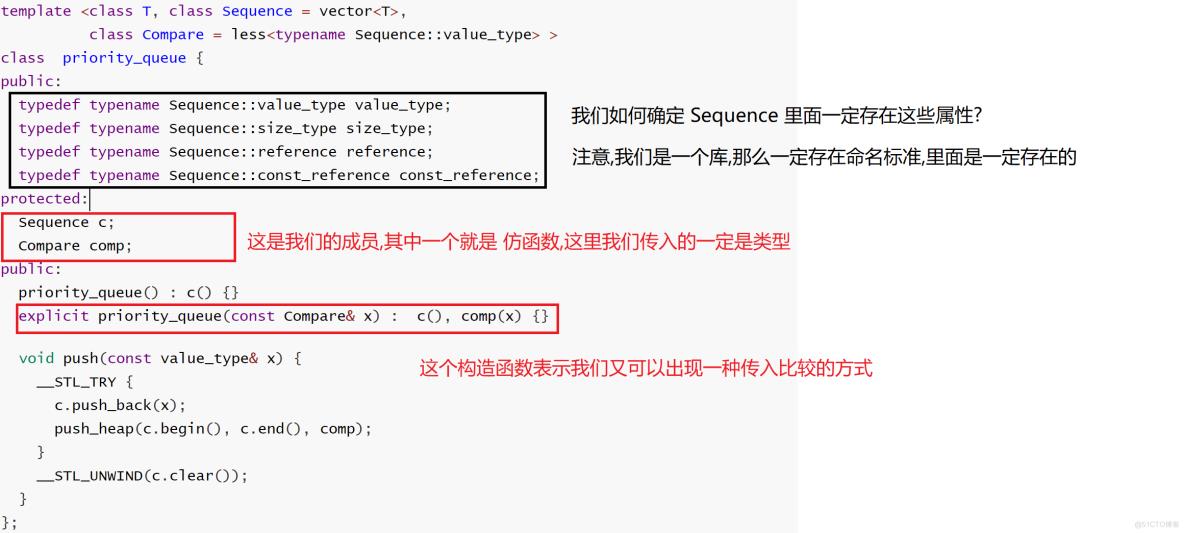priority_queue使用 这里说一下优先级队列的其他的用法,这里我们先看默认的究竟是建立大堆还是小堆? #include iostream#include queueint main(){int arr[] = { 10, 2, 1, 3, 5, 4, 0 };std::priority_queueint q;for
priority_queue使用
这里说一下优先级队列的其他的用法,这里我们先看默认的究竟是建立大堆还是小堆?
#include <iostream>
#include <queue>
int main()
{
int arr[] = { 10, 2, 1, 3, 5, 4, 0 };
std::priority_queue<int> q;
for (size_t i = 0; i < sizeof(arr)/sizeof(arr[0]); i++)
{
q.push(arr[i]);
}
while (!q.empty())
{
std::cout << q.top() << " ";
q.pop();
}
return 0;
}
是大堆,那么我们应该如何让他建立成小堆呢?先来它他们的构造函数.

这个是C++98的,我们发现这里有两个,这里测试第一个,我们发现comp是一个对象,此时我们就想到了仿函数对象,那么是不是呢?直接测试.
#include <iostream>
#include <queue>
#include <vector>
int main()
{
int arr[] = { 10, 2, 1, 3, 5, 4, 0 };
std::priority_queue<int, std::vector<int>, std::less<int>> q;
for (size_t i = 0; i < sizeof(arr)/sizeof(arr[0]); i++)
{
q.push(arr[i]);
}
while (!q.empty())
{
std::cout << q.top() << " ";
q.pop();
}
return 0;
}
那么greater就是小根堆了,测试一下.
#include <iostream>
#include <queue>
#include <functional>
int main()
{
int arr[] = { 10, 2, 1, 3, 5, 4, 0 };
std::priority_queue<int, std::vector<int>, std::greater<int>> q;
for (size_t i = 0; i < sizeof(arr) / sizeof(arr[0]); i++)
{
q.push(arr[i]);
}
while (!q.empty())
{
std::cout << q.top() << " ";
q.pop();
}
return 0;
}
下面我们测试一下自定义类型的入堆操作,这里我们直接写出一个仿函数.
struct node
{
int x;
int y;
};
struct cmp
{
bool operator()(const node& n1, const node& n2){
return n1.x > n2.x;
}
};
int main()
{
node n1 = { 1, 2 };
node n2 = { 2, 4 };
node n3 = { 3, 4 };
priority_queue<node, vector<node>, cmp>q;
q.push(n1);
q.push(n2);
q.push(n3);
return 0;
}
如果我们要是不想写仿函数,那么我们在结构体里面重载<操作符,看大家的喜好吧.
struct node
{
int x;
int y;
bool operator<(const node& n) const
{
return x > n.x; // 这里可以控制是大堆还是小堆
}
};
int main()
{
node n1 = { 1, 2 };
node n2 = { 2, 4 };
node n3 = { 3, 4 };
priority_queue<node>q;
q.push(n1);
q.push(n2);
q.push(n3);
return 0;
}
priority_queue源码
这里我们简单的分析一下源码,主要是加深一下印象.
template <class T, class Sequence = vector<T>,
class Compare = less<typename Sequence::value_type> >
class priority_queue {
public:
typedef typename Sequence::value_type value_type;
typedef typename Sequence::size_type size_type;
typedef typename Sequence::reference reference;
typedef typename Sequence::const_reference const_reference;
protected:
Sequence c;
Compare comp;
public:
priority_queue() : c() {}
explicit priority_queue(const Compare& x) : c(), comp(x) {}
void push(const value_type& x) {
__STL_TRY {
c.push_back(x);
push_heap(c.begin(), c.end(), comp);
}
__STL_UNWIND(c.clear());
}
};先来得到第一个结论

试一下上面我们说的,新的构造方式,不过我们很少用.
struct node
{
int x;
int y;
};
struct cmp
{
bool operator()(const node& n1, const node& n2){
return n1.x > n2.x;
}
cmp(const cmp& c)
{
}
cmp()
{
}
};
int main()
{
node n1 = { 1, 2 };
node n2 = { 2, 4 };
node n3 = { 3, 4 };
cmp c;
priority_queue<node, vector<node>, cmp> q(c);
q.push(n1);
q.push(n2);
q.push(n3);
return 0;
}
下面我们来谈当我们数据进入数组的时候,我们调整堆的操作,这里不做具体的分析,就谈为何我们的重载了<就不用写仿函数了,应该是这个函数,我们直接来分析一下吧.
template <class RandomAccessIterator, class Distance, class T, class Compare>
void __push_heap(RandomAccessIterator first, Distance holeIndex,
Distance topIndex, T value, Compare comp) {
Distance parent = (holeIndex - 1) / 2;
while (holeIndex > topIndex && comp(*(first + parent), value)) {
*(first + holeIndex) = *(first + parent);
holeIndex = parent;
parent = (holeIndex - 1) / 2;
}
*(first + holeIndex) = value;
}首先我们调用的是默认的无参构造函数,此时我们的Compare的实际类型是less\<Node\>,后面我们使用比较的,那么此时我们使用的就是less类型的,也就是我们的标准提供的仿函数.

struct node
{
int x;
int y;
bool operator<(const node& n) const
{
return x > n.x; // 这里可以控制是大堆还是小堆
}
};
int main()
{
node n1 = { 1, 2 };
node n2 = { 2, 4 };
node n3 = { 3, 4 };
priority_queue<node>q;
q.push(n1);
q.push(n2);
q.push(n3);
return 0;
}下面就到了观察less类型了,我们这里继续进去看.
template <class T>
struct less : public binary_function<T, T, bool> {
bool operator()(const T& x, const T& y) const { return x < y; }
};看到了吗.这里面重载了括号,看到函数体内存在一个<吗?这里调用的就是我们在Node中写的<重载操作符,这里就是我们为何是这样的.那么此时我们也可以重载>,看下面的操作.
struct node
{
int x;
int y;
bool operator>(const node& n) const
{
return x > n.x;
}
};
int main()
{
node n1 = { 1, 2 };
node n2 = { 2, 4 };
node n3 = { 3, 4 };
priority_queue<node, vector<node>, greater<node>>q;
q.push(n1);
q.push(n2);
q.push(n3);
return 0;
}
